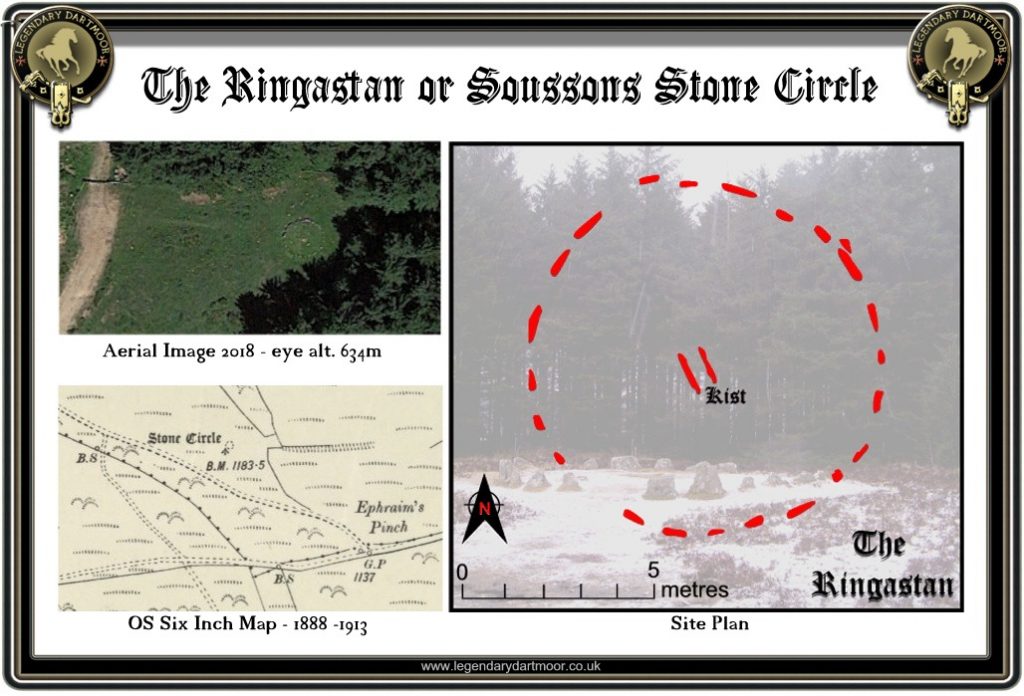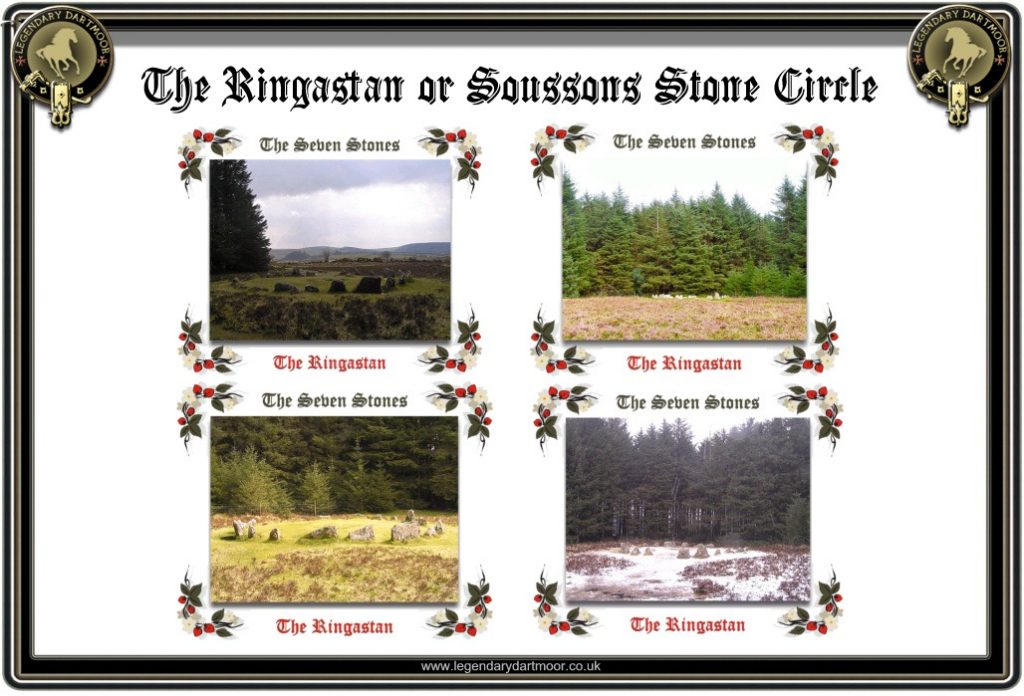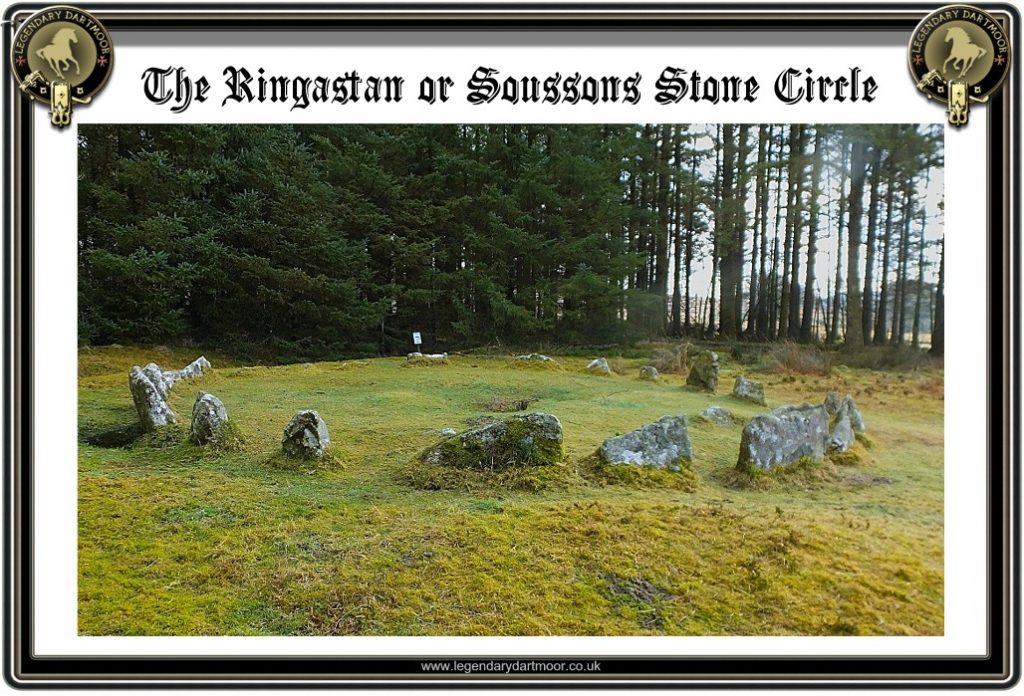
Drive up past Ephraim’s Pinch and you will arrive at what must be the most accessible Bronze Age relic on Dartmoor, it is literally 20 yards from the road. In the summer the small stone circle becomes a favourite picnic spot but in winter it is a magical place to visit. On really cold, windy days you will often find some of the moor ponies sheltering beneath the conifers. Sadly, the circle is like Bellever and Lake Hill, another example of the total disregard for the archaeology shown by the foresters of the early 1900’s. The 1946 plantation must have covered up a great deal of the Bronze Age landscape features, a fact born out by the following letter which appeared in the Western Morning Times on the 2nd of March 1948; “… Soussons Common was recently handed over to the forestry Commission, with the result we have seen. Up went the wire fences, in went the giant plough; the once beautiful heather-covered common was trenched and planted from end to end; the prehistoric stone circle and tumuli were encompassed by a regiment of seedling firs…” Not only have the adult trees obliterated the Bronze Age features they have also covered the remains of an old rabbit warren and some old tin mining relics. The map extract from the 1888 Ordnance Survey below gives some idea what the area looked like before the coming of the plantation. Fortunately in the past few years there has been a certain degree of deforestation which is slowly expanding the views around the circle.
The small circle is located right on the very southern edge of the Soussons Plantation and is known by various names: Soussons Common Circle, Ephraim’s Pinch Circle, Soussons Field Circle, these being a few of its modern names. However, go way back in history and you will find a few more: the Ring of Stones, Ringastan, and Seven Stones. These reflect the usage of prehistoric sites as ancient boundary markers. Probably, as Brewer notes, the earliest mention being that of the Saxon ‘Peadington Landscore‘ which could date to between the 8th and 10th centuries. The document is thought to refer to a Saxon Estate and in it records the following boundary points: “Of Cealfa dune on Sufen stanas“, from the cold down to the seven stones. Then, “Of Sufon stanum on Hyfan treow“, – from Seven Stones to the Hive Tree. Saxon boundaries quite often used such sites as markers, Hooke, 2001, p.98 notes how, “In their boundary clauses the Anglo Saxons frequently referred to features of an earlier period and were obviously familiar with there use“. In this light, Brewer, p. 303, considers that in the case of the term ‘Seven Stones’ it refers to any pre-Christian burial site regardless of the number of stones present. It is thought that the place-names of the area such as Soussons Common, Down, Farm, Plantation, and Warren all allude to the Saxon name – ‘Seven Stones’. Gover et al, 1998, p. 482, state that in Birch’s Cartularium Saxonicum of 1323, the Sufen Stanas as mentioned above would have been the root of Soussons, meaning ‘at the seven stones’. The other name, ‘Ringastan’ or Ring of Stones’ comes from the boundary of Spitchwick where once again the circle was a maker point. In 1752 the bounds for the manor of Spitchwick stated: “and is lineable to a place called Ring of Stones otherwise Ringastan…”.
As previously mentioned the circle is in fact a cairn circle dating to the Bronze Age. Butler, 1991, p.19. describes the circle as consisting of 22 visible stones with a diameter of 8.6m., at the centre of which are the remains of a kist . When the Dartmoor Exploration Committee excavated the kist in 1903 they discovered that there was a false paved floor under which was hidden two large coils of human hair. The hair was then sent to a certain Mr. F. T. Elworthy (the author of ‘The Evil Eye‘) who commentated that: “I think that there is no sort of doubt that the deposit was made in comparatively modern times relatively to the kistvaen by someone who knew of the latter and desired to work a spell of the former possessor of the hair. I have referred to the belief that sympathetic magic can be worked by the possession of any article (especially hair) that belonged to a person to whom it is desired to work evil.” Whether or not it was the discovery of the human hair and the so-called associations with ‘witchcraft’ that has led to alleged rituals taking place in and around the circles nobody is sure. It also may be coincidences that at or or near the various equinoxes connected to such rituals that fires appear on the site? Whether it be for this reason or to deter visitors lighting barbecues in the kist in 1994 the D.N.P.A. filled it in. This was to prevent the heat from the fires splitting the side slabs of the kist. But, as always this has not stopped the problem as can be seen from the various photographs below, with the latest occurrence being in 2019. In latter years there has also been a trend of leaving votive offerings of various kinds in the kist, again as can be seen below.

However, it is a magical site to visit and I must confess I always pop in whenever passing as the changing year adds numerous facets to the place. I will warn you now, that on a hot, muggy day you will pay dearly for your visit as the site is notorious for its local midge population. On one memorable visit the whole area was tinted with the hues of early autumn and the flies were in a particularly vicious mood.

Brewer, D. 2002 Dartmoor Boundary Markers, Halsgrove Pub., Tiverton.
Butler, J. 1997 Dartmoor Atlas of Antiquities – Vol. V, Devon Books, Exeter.
Butler, J. 1991 Dartmoor Atlas of Antiquities – Vol. II, Devon Books, Exeter.
Gover, J. E. B., Mawer, A. & Stenton, F. M. 1992 The Place Names of Devon, English Place-Name Society, Nottingham.
Hooke, D. 2001 The Landscape of Anglo Saxon England, Leicester Univ. Press, London
 Legendary Dartmoor The many aspects past and present of Dartmoor
Legendary Dartmoor The many aspects past and present of Dartmoor




I often pass by this ring of stones late at night, en route from Postbridge to Widecombe, and like to park and switch off all the lights of my vehicle. On a clear night the moon and stars provide a fascinating, if eerie, backdrop to the silent ring of stones and the darkness of the forest.